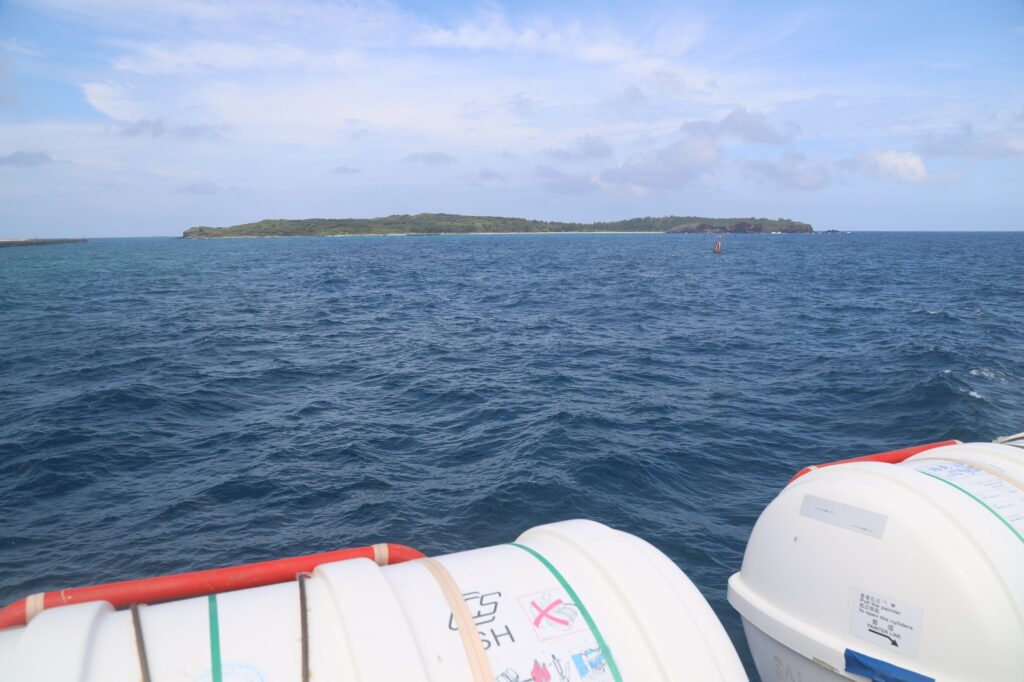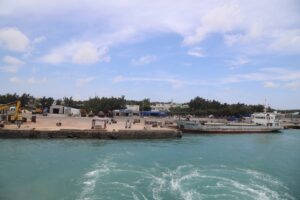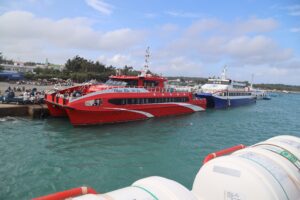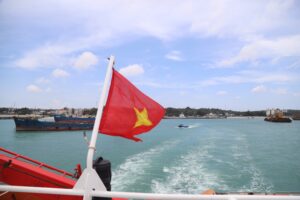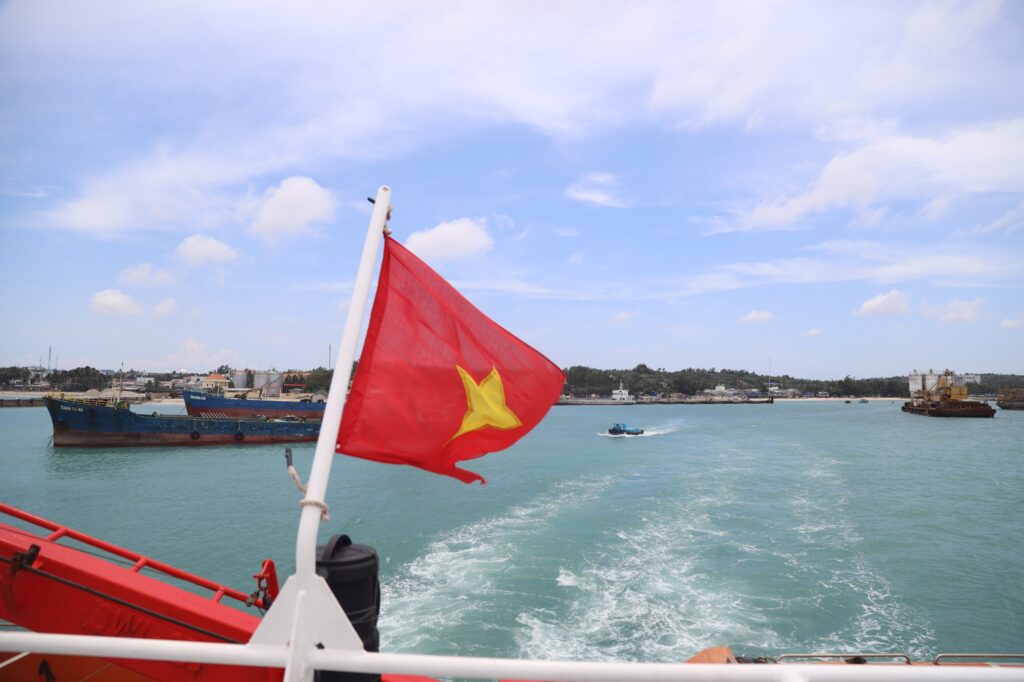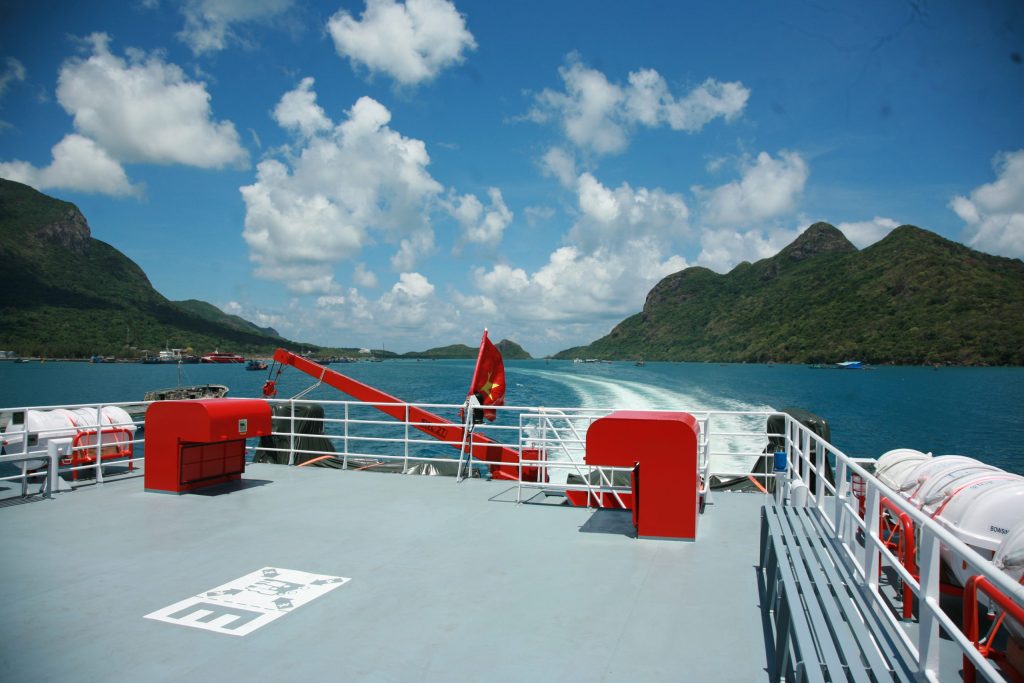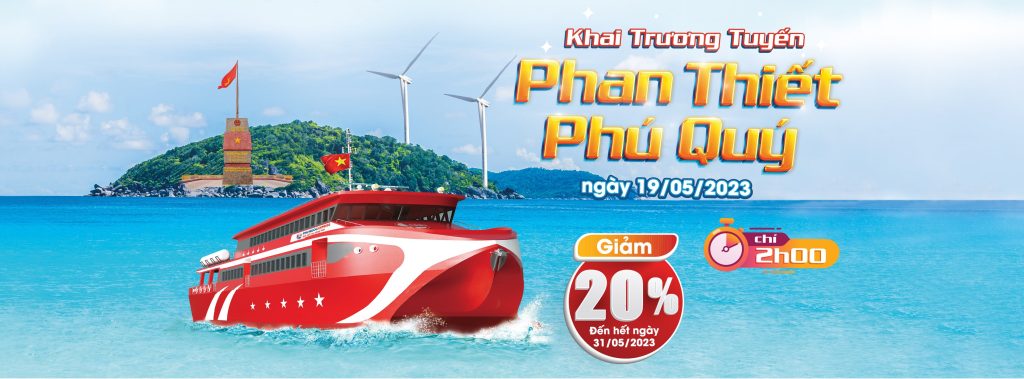With years of experience assisting thousands of travelers in booking high-speed ferry tickets to Phu Quy, we’ve compiled a list of the TOP tourist attractions in Phu Quy that are most visited by travelers upon setting foot on this beautiful island!
Linh Son Pagoda – Cao Cat Mountain
Linh Son Pagoda – Cao Cat Mountain is one of the most renowned scenic complexes in Phu Quy District, located in Long Hai Commune.
Cao Cat Mountain is considered sacred by islanders. Located in the northern area of the island, the mountain features an imposing statue of the Goddess of Mercy (Guanyin) at its peak. The locals regard it as a sacred mountain and a symbol of the Sea Dragon. Formed from a coral mountain eroded by wind and waves, Cao Cat has spiraling rock formations resembling giant mushrooms. There are also many primal rocks and mysterious caves that spark curiosity and interest.
From the summit, visitors can see Sai Nai Master’s Tomb in the east surrounded by dark rock reefs, lush green fields to the south, Princess Ban Tranh’s Temple and Mount Cam with its towering lighthouse to the west, and the wind power stations of Ngu Phung to the north.
Perched atop Cao Cat Mountain, Linh Son Pagoda was built about 100 years ago at an elevation of 106 meters above sea level. There is no permanent abbot; instead, local Buddhists take turns conducting rituals and warmly welcoming visitors. Both sides of the trail leading up to the pagoda are lined with dense, ancient trees, adding a mystical charm to the sacred site.
Tourism offerings here include sightseeing at Linh Son Pagoda and Cao Cat Mountain, spiritual-cultural tours, community-based tourism, and research into the pagoda’s development.
Sai Nai Master’s Tomb
Located in Dong Hai Hamlet, Long Hai Commune, Sai Nai Master’s Tomb is a cultural and historical relic reflecting the interactions between Vietnamese and Chinese people in the island’s early days. Built in the 17th century, this sacred site has long played an important role in the islanders’ spiritual life.
At the foot of the tomb’s cape lies a wave-breaker aquaculture area, which supplies seafood to Long Vi Restaurant and serves as a scenic spot perfect for photography. Tourists can explore spiritual beliefs at the tomb, its architecture, and visit nearby fish cages and the cape for sightseeing.
Hon Tranh Islet
The largest islet near Phu Quy, Hon Tranh spans 2.7 km² and is the most visited spot among surrounding islets. Located about 15 minutes southeast of the main island by motorboat, the islet used to be covered with cogon grass used by locals to build houses.
Here, you’ll find a temple dedicated to General Bui Huu Ich and another worshipping 77 South Sea deities. Annual ceremonies are held in the 3rd and 8th lunar months to honor these spirits and pray for prosperity. A notable freshwater well, known as Nguyen Anh’s Well, remains full year-round regardless of rain or drought.
The southern sea area boasts many scenic spots such as Vung Gam, Vung Ban, Mũi Xuong Ca, Vung Phat, Hang Co Nuoc, and Hang Co Kho. The island is also dotted with mysterious caves and striking rock formations in indigo and moss green.
With calm seas and clear water year-round, Hon Tranh is perfect for snorkeling, fishing, and exploring marine life. The islet hosts a few long-term residents and a radar station operated by the Vietnamese Navy. Tourists can enjoy fresh air, cook seafood, and learn about the islet’s unique stories and history.
Cam Mountain
Cam Mountain is one of two main peaks on Phu Quy Island, reaching 108 meters above sea level in Ngu Phung Commune. At the summit stands Vietnam’s largest lighthouse, which provides guidance for sea travelers at night.
Visitors can climb stone steps under the shade of lush trees to reach the top. Beside the lighthouse is a statue of President Ho Chi Minh and a flaming torch sculpture, leading locals to call it “Uncle Ho’s Torch.” From here, you can admire the island’s sweeping scenery of greenery and ocean waves.
This site is ideal for mountain exploration, island-wide sightseeing, community gatherings, patriotic storytelling, and honoring local heroes who safeguard the island.
Bai Nho – Ganh Hang Beach
Bai Nho is one of Phu Quy’s most beautiful beaches, featuring soft white sand and clear turquoise water. Nestled at the base of a hill about 10 minutes from the island center, the area remains relatively untouched. Surrounded by unique black rock formations, it offers stunning sunrise views when the sea sparkles like it’s been dusted with glitter.
In calm weather, Bai Nho becomes a paradise with golden sunshine, refreshing waters, and peaceful seclusion. It’s ideal for relaxation, water sports, and geological exploration of the area’s unique black rock structures.
Doi Dua Beach
Located in Ngu Phung Commune, near the island center, Doi Dua Beach features calm, clear water and soft white sand. Lush coconut trees along the shore add to the serene and picturesque setting. It takes about 7 minutes by motorbike from the center to reach the beach, which is a favorite spot for swimming, relaxing, and enjoying Phu Quy’s coastal beauty.
Trieu Duong Bay
Stretching about 2 km in Tam Thanh Commune, Trieu Duong Bay offers flat beaches, white sand, and clear blue water lined with lush Casuarina trees. Visitors can join locals in experiencing a day in the life of a fisherman: casting nets, fishing, and harvesting seafood.
On holidays and festivals, both locals and tourists gather here for cultural activities like music, cooking competitions, and folk games. Tourism activities here include sightseeing, relaxation, culinary festivals, and community experiences to learn about the local lifestyle.
Phu Quy Flagpole
Built in 2015 on nearly 200m² at the easternmost point of Chuoi Hill, overlooking Ganh Hang Beach, this sacred sovereignty marker has become a must-visit site. Tourists can hike Chuoi Hill, swim at Ganh Hang, snorkel, and join storytelling competitions at the flagpole.
Lach Du Fish Farm
At Lach Du grouper fish farm, visitors can explore the daily life of island fishermen. After swimming and snorkeling, guides take guests by boat to the floating farm, where they can choose live seafood and prepare their own fresh dishes.
This community-based ecotourism model is increasingly popular, attracting both tourists and locals. Activities include culinary exploration, boat tours, snorkeling, seafood cooking, and buying seafood as souvenirs.
Lang Co Breakwater (Colorful Breakwater Wall)
Recently, the Lang Co Breakwater has become a hot spot for photography and relaxation. Once dull gray, the breakwater now bursts with colors thanks to volunteers from Binh Duong Province’s Green Summer Campaign and local youth. It offers a vibrant space to admire the sea, watch boats, and enjoy sunrise or sunset on the island.
Linh Quang Pagoda
Located in Tam Thanh Commune on a gentle hill, Linh Quang Pagoda offers a peaceful retreat away from worldly life. As the first Buddhist temple on the island, it played a key role in introducing Buddhism to Phu Quy. Aside from its scenic setting, the temple holds great historical, literary, and artistic value.
Recognized as a National Scenic Site by the Ministry of Culture and Information in 1996, Linh Quang welcomes visitors for spiritual reflection, historical research, and studying preserved imperial edicts from the Nguyen Dynasty.



